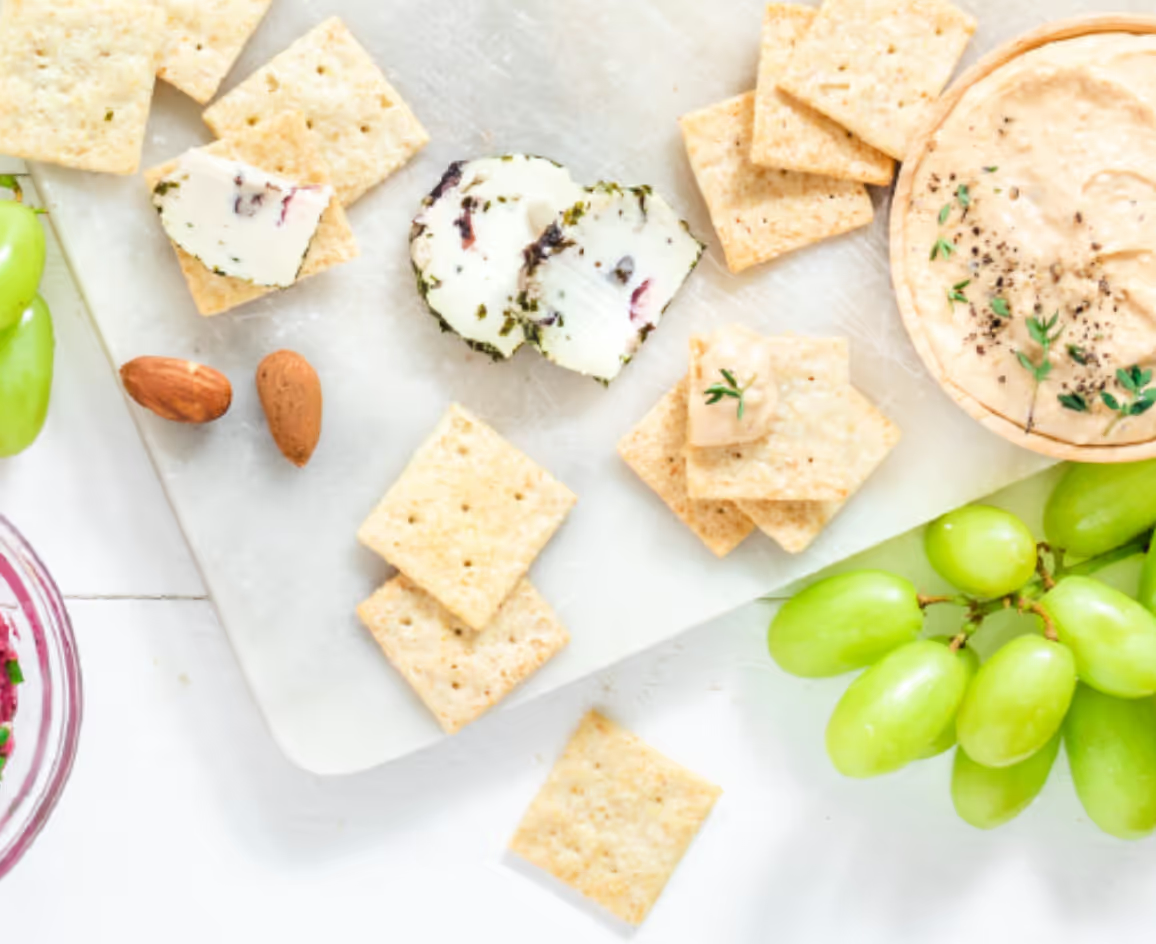How to Make a Low Cholesterol Diet Plan
Learn the importance of nutrition in lowering cholesterol levels with our guide on the best and worst foods, plus a low cholesterol diet plan.

A primary care membership for patients who want more. Primary Care. Nutrition. Wellness. All under one roof.
High cholesterol is one of the most prevalent risks of heart disease, but with a healthy diet and lifestyle it’s also one of the most preventable. While it might seem overwhelming to try and lower your cholesterol levels, there is one major factor that comes with a big payoff: eating a heart-healthy diet that is rich in fiber.
Here’s what you need to know about what to eat to lower cholesterol and how to get more of the good stuff into your diet.
Why Nutrition Is Important to Lower Cholesterol
Cholesterol is a waxy, fat-like substance that’s found in all of your cells. It is important for many of your body's functions, such as making hormones, making vitamin D, and producing substances that help you digest food. While most of us think about cholesterol as being something negative, the truth is that it’s a little more complicated than that.
There are two main types of cholesterol: low-density lipoprotein (LDL), commonly known as bad cholesterol, and high-density lipoprotein (HDL), or good cholesterol. Let’s see why they have earned this descriptions:
- If you have too much LDL cholesterol in your blood it can build up, stick to the walls of your arteries, and narrow or even block them. High LDL cholesterol levels can put you at risk for heart disease, one of the country’s leading causes of death.
- HDL cholesterol, on the other hand, helps eliminate “bad” LDL cholesterol by absorbing and carrying it back to the liver, which then flushes it from the body.
As you can see, when it comes to how much cholesterol you need, it’s a delicate balance—just enough is vital, while too much can lead to trouble.
Here at The Lanby, we can help you monitor your cholesterol levels through blood work. In addition, our providers look at a few measures of cholesterol that many doctors don’t include in routine lab work. One is a protein called apolipoprotein B (ApoB), which transports LDL throughout the body. This single biomarker can give us a really direct measure of the number of those particles that are in the bloodstream, and in some cases this can be a better indicator of LDL on its own.
Like many health conditions, cholesterol levels primarily depend on your dietary habits. If you suffer from high LDL, making changes to your diet can have a dramatic effect on improving your risk of heart disease. It’s not just about limiting foods high in saturated fat and avoiding foods with trans fats, it’s also about adding cholesterol-lowering foods such as plenty of fruits and vegetables, and foods rich in omega-3 fatty acids.
The Best Foods for Lowering Your Cholesterol: What to Eat and Why
Diet plays a huge role in your cholesterol levels and your heart health. Below is our top list of foods that help you have more good cholesterol.
Fruits and vegetables
Fruits and vegetables are one of the best sources of fiber, one of the most effective macronutrients to reduce cholesterol. Fiber helps increase the liver’s production of bile acid, which is needed for removing excess cholesterol from the body. Foods high in fiber also have anti-inflammatory properties and help stabilize blood sugar levels.
Some of the highest fiber fruits and vegetables include: non-starchy vegetables like leafy greens, cabbage, broccoli, cauliflower, asparagus and brussel sprouts as well as celery, artichokes, onions, sweet potatoes, bananas, blueberries, raspberries, apples, and pears. Aim to eat 7-8 servings of fruits and veggies per day.
Whole grains
Whole grains such as oats, barley, and brown rice are a good source of soluble fiber. Soluble fiber soaks up water in the digestive tract to form a gel, which can bind on to the fat and cholesterol from our food and prevent some of it from entering the bloodstream. When the bacteria in our gut consume the gel, it produces short-chain fatty acids that have been shown to lower cholesterol.
Swap your morning cereal for a bowl of oatmeal topped with walnuts and berries or swap white rice for brown rice at dinner.
Legumes
Similarly to whole grains, legumes such as lentils, black beans, chickpeas, soybeans, and kidney beans are also a good source of soluble fiber. They’re also high in plant based protein, making them a great alternative to animal protein, which is something to be more mindful about consuming if you have high cholesterol.
Eat 1-2 servings of beans daily as part of a heart healthy diet. Make stir-fry with tofu instead of steak, tacos with black beans instead of ground beef or a vegetarian chili with chickpeas and kidney beans.
Fish
Another excellent choice to help lower cholesterol is to eat more fish, particularly fish high in omega-3 fatty acids such as salmon, sardines, herring, mackerel, and trout. Not only is it a great alternative to meat, but omega-3 fatty acids lower blood pressure and heart rate, improve blood vessel function, and ease inflammation.
Aim to incorporate fish into your diet 2-3 times a week. Vital Choice and Safe Catch are great places to source sustainable seafood.
Fermented dairy
Studies suggest that fermented dairy products such as greek yogurt, cottage cheese, and kefir can help reduce LDL cholesterol and increase HDL cholesterol. They’re also a good source of natural probiotics, which help support a healthy gut. Greek yogurt or cottage cheese with berries is one of our go-to snacks!
Nuts and seeds
Nuts contain heart-healthy unsaturated fatty acids, fiber, and antioxidants. Therefore, consuming nuts can lower the risk of coronary heart disease and various other heart conditions. Some of the best nuts you can consume in a low cholesterol diet are walnuts, almonds, and pistachios. A bag of heart-healthy trail mix is a great snack to have with you while you're on-the-go or at the office.
Chia seeds and ground flax seeds might be small, but they pack a big punch—one tablespoon contains 3-5 grams of fiber. Add them to your morning smoothie or oatmeal or make chia seed pudding.
Olive oil
Extra virgin olive oil is a great source of healthy fats and contains an adequate amount of polyphenol and monounsaturated fatty acids that increase HDL, the good kind of cholesterol, in the body. Olive oil should be the primary oil used when cooking or dressing salads.
Green tea
The active ingredient in green tea, known as catechin extract, plays a role in increasing the function of LDL receptors in the liver and preventing the absorption of cholesterol in the intestines. It’s also a powerhouse of antioxidants, which supports whole body health. A cup of green tea is the perfect afternoon pick-me-up.
It’s important to note that there is no single food that will help you lower your cholesterol levels: It’s all about trying to incorporate a variety of foods at each meal. As a start, check out our guide on how to build a balanced plate.

High-Cholesterol Foods to Avoid
While we like to keep our attention on filling up on all of the heart-healthy foods to help naturally crowd out foods that aren’t as supportive, below is a list of foods you should avoid or limit.
Fried foods
French fries, fried chicken, and other deep-fried foods have excess saturated fat and cholesterol from the inflammatory oils they’re cooked in. Additionally, deep-frying food removes the natural water content and replaces it with unhealthy oil, making it more calorie-dense and high in trans fats compared to their natural state. Opt for baked or grilled foods cooked in heart-healthy olive oil instead.
Processed meat
Bacon, hot dogs, and sausages are usually made using the fattiest cuts of beef or pork. The high fat content in processed meat is bad for your heart as it increases LDL cholesterol in the body, so it's important to limit the intake.
Processed sugar and carbohydrates
Processed foods such as cookies, cakes, donuts, cereal, chips, crackers, white bread, and pasta have been highly refined and stripped of any nutritional value. They are often made with inflammatory oils and have added sugar, making them one of the worst offenders for high cholesterol.
Instead, focus on eating whole food snacks like fresh fruit and nuts or veggies and hummus. Enjoy baked goods sparingly, homemade is preferred! And opt for items made with better ingredients such as almond, brown rice or oat flour instead of white flour. and maple syrup instead of sugar.

Other tips to maintain a healthy cholesterol
Exercise
Getting enough exercise is key to reducing cholesterol levels. Strength training and cardio exercises such as brisk walking, jogging, cycling, and swimming all help to increase overall fitness and reduce body fat percentage, lowering cholesterol. Aim for at least 150 minutes of moderate exercise per week.
Weight loss
Losing weight has been found to decrease cholesterol levels. Incorporating regular exercise and eating a heart-healthy, whole-food diet are the first steps towards shedding unwanted pounds and improving cholesterol.
Avoid alcohol
Excessive alcohol consumption contributes to obesity and higher levels of fat on the body. Being obese can raise your LDL level and lower your HDL level, so you want to limit your alcohol intake to maintain healthy cholesterol levels.
Stop smoking
Smoking increases LDL cholesterol levels while decreasing HDL levels, putting smokers at greater risk of coronary heart disease.

Low Cholesterol Diet Plan for You
Below is an example of a diet plan to help lower cholesterol and support overall health. Pick and choose which meals sound the best to you and go from there. If you’re vegetarian or vegan, swap any animal protein with a plant-based source of protein such as tofu, lentils, black beans, chickpeas, kidney beans or quinoa.
Breakfast
- Smoothie with unsweetened almond milk, almond butter, frozen banana, and spinach
- Oatmeal with walnuts and berries
- Greek yogurt with chia, flax seeds and berries
- Scrambled eggs with sauteed spinach and avocado
- Avocado toast with smoked salmon.
Lunch
- Salad with beans of choice and avocado
- Salad with grilled salmon and avocado
- Salad with roasted chicken and walnuts
- Grain bowl with brown rice, beans, avocado, leafy greens
- Lentil soup and side salad.
Snack
- Apple with almond butter
- Handful of nuts (walnuts, almonds, pistachios)
- Cottage cheese and berries
- Hummus with carrots and celery sticks
- Hard boiled eggs.
Dinner
- Salmon with roasted brussel sprouts and brown rice
- Chicken with roasted asparagus and sweet potato
- Tofu stir fry with carrots, broccoli, cauliflower, cabbage and brown rice
- Tacos with black beans, peppers, onions, on a grain-free or 100% corn tortilla
- Sweet potato stuffed with chickpeas and kale.
A few tips to help you prepare your meals:
- Make your meal plan and do your shopping before the start of the week. Sunday’s are a great day for this!
- Meal prep or batch cook key ingredients to help make weekday meals easier to throw together. For example, pre-wash, chop and roast veggies, cook grains like brown rice or quinoa, and bake chicken.
- Store your food in glass containers to prevent chemicals from plastic leaching into your food. We love Porter food storage containers.
A dietitian, like ours at The Lanby, can help you create a personalized plan for a low cholesterol diet that works best for you. Additionally, our physicians can help you stay on top of your cholesterol numbers through routine blood work. Book a free consult.

Conclusions
High cholesterol is a pervasive issue among Americans, but can be managed with a healthy diet and lifestyle. The most significant way to maintain healthy cholesterol levels is to favor foods rich in fiber, plant based protein, and omega-3 fatty acids over red meat and processed foods.
In addition, doing regular physical activity, having a healthy weight, and quitting habits such as smoking and drinking can lower cholesterol levels.
The Lanby is a primary care membership for patients who want more. Book a free consult!

If you're curious to learn more about The Lanby, book a free consult call and we'll chat about how The Lanby can be your personalized long term health and wellness partner.

Kendall is a graduate of the University of Mississippi, with a B.A. in Integrated Marketing Communications and a minor in Business Administration. She received her certificate of Nutrition Science from the Friedman School of Nutrition at Tufts University.

Chloe holds a bioengineering degree from the University of Pennsylvania. As a breast cancer survivor, her insights shape The Lanby's patient-centric approach. Leveraging her healthcare strategy background, Chloe pioneers concierge medicine, bridging gaps in primary care.

Tandice was recognized with the Health Law Award and named a Ruth Bader Ginsburg Scholar at Columbia Law School. Tandice's editorial role is enriched by her insights into patient autonomy and gene modification legalities. Passionate about bioethics, she is committed to crafting patient-centric healthcare solutions.





